Finance Project Report: Ratio Analysis, BEP, DOL, DFL, Loan Recommendation, Policy Change Impact
VerifiedAdded on 2023/06/15
|9
|1361
|440
AI Summary
This finance project report covers different aspects of finance such as ratio analysis, BEP, DOL, DFL, loan recommendation, and policy change impact. It includes calculations and recommendations for different scenarios. The report covers topics such as liquidity, debt, asset utilization, profitability, and financial leverage. It also includes a loan recommendation for Ryan Boot and an analysis of the impact of changing credit policy.
Contribute Materials
Your contribution can guide someone’s learning journey. Share your
documents today.
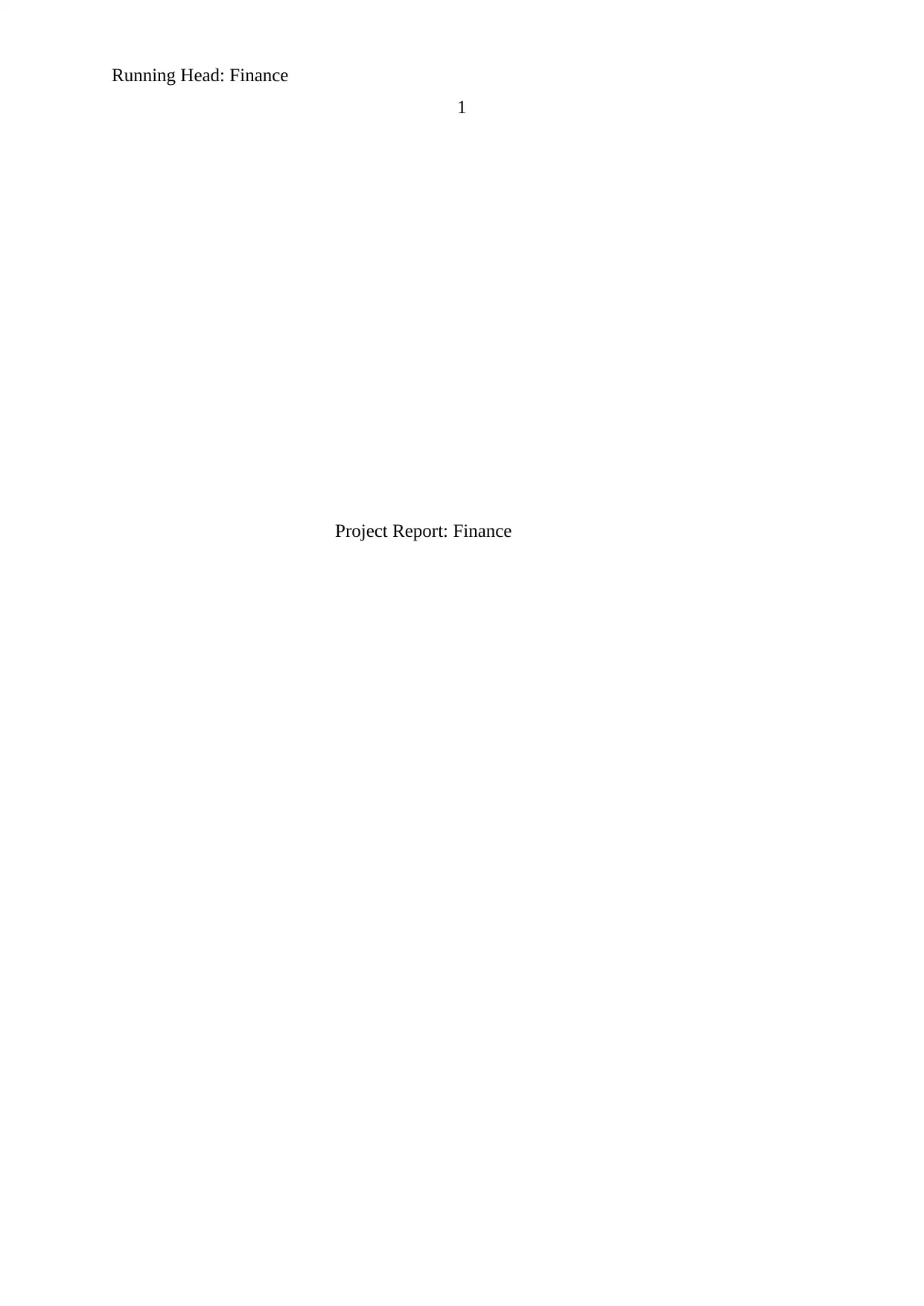
Running Head: Finance
1
Project Report: Finance
1
Project Report: Finance
Secure Best Marks with AI Grader
Need help grading? Try our AI Grader for instant feedback on your assignments.
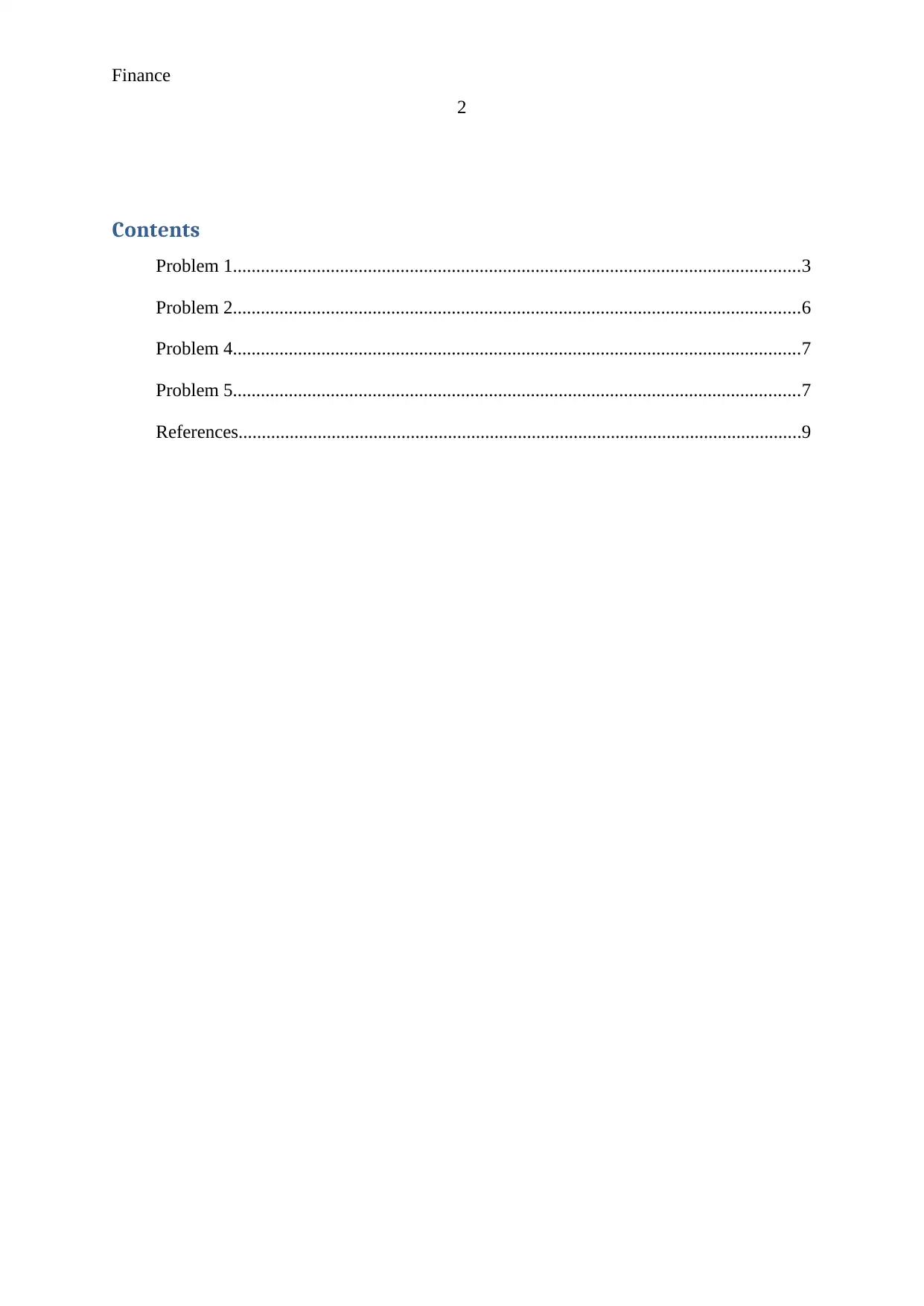
Finance
2
Contents
Problem 1..........................................................................................................................3
Problem 2..........................................................................................................................6
Problem 4..........................................................................................................................7
Problem 5..........................................................................................................................7
References.........................................................................................................................9
2
Contents
Problem 1..........................................................................................................................3
Problem 2..........................................................................................................................6
Problem 4..........................................................................................................................7
Problem 5..........................................................................................................................7
References.........................................................................................................................9
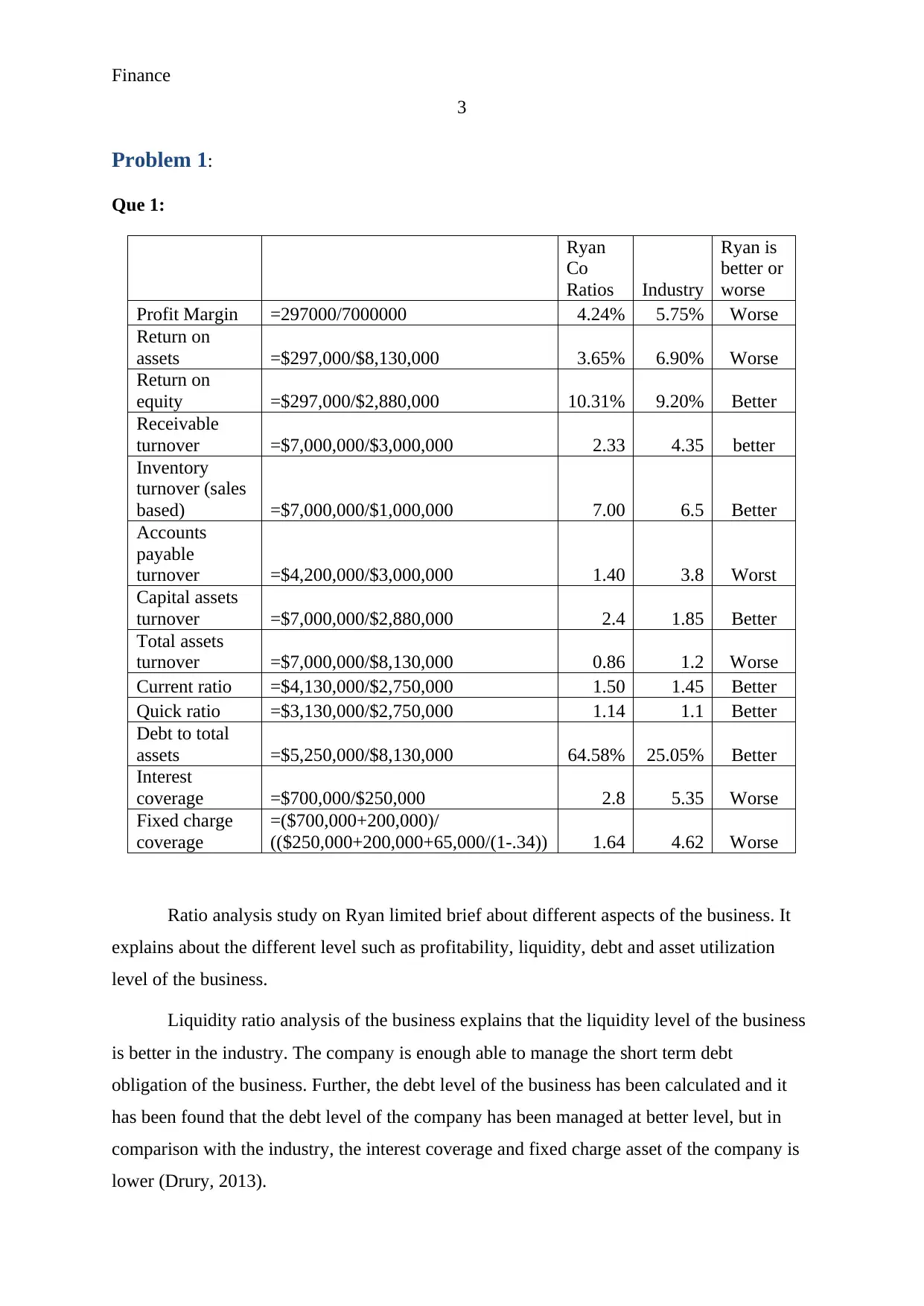
Finance
3
Problem 1:
Que 1:
Ryan
Co
Ratios Industry
Ryan is
better or
worse
Profit Margin =297000/7000000 4.24% 5.75% Worse
Return on
assets =$297,000/$8,130,000 3.65% 6.90% Worse
Return on
equity =$297,000/$2,880,000 10.31% 9.20% Better
Receivable
turnover =$7,000,000/$3,000,000 2.33 4.35 better
Inventory
turnover (sales
based) =$7,000,000/$1,000,000 7.00 6.5 Better
Accounts
payable
turnover =$4,200,000/$3,000,000 1.40 3.8 Worst
Capital assets
turnover =$7,000,000/$2,880,000 2.4 1.85 Better
Total assets
turnover =$7,000,000/$8,130,000 0.86 1.2 Worse
Current ratio =$4,130,000/$2,750,000 1.50 1.45 Better
Quick ratio =$3,130,000/$2,750,000 1.14 1.1 Better
Debt to total
assets =$5,250,000/$8,130,000 64.58% 25.05% Better
Interest
coverage =$700,000/$250,000 2.8 5.35 Worse
Fixed charge
coverage
=($700,000+200,000)/
(($250,000+200,000+65,000/(1-.34)) 1.64 4.62 Worse
Ratio analysis study on Ryan limited brief about different aspects of the business. It
explains about the different level such as profitability, liquidity, debt and asset utilization
level of the business.
Liquidity ratio analysis of the business explains that the liquidity level of the business
is better in the industry. The company is enough able to manage the short term debt
obligation of the business. Further, the debt level of the business has been calculated and it
has been found that the debt level of the company has been managed at better level, but in
comparison with the industry, the interest coverage and fixed charge asset of the company is
lower (Drury, 2013).
3
Problem 1:
Que 1:
Ryan
Co
Ratios Industry
Ryan is
better or
worse
Profit Margin =297000/7000000 4.24% 5.75% Worse
Return on
assets =$297,000/$8,130,000 3.65% 6.90% Worse
Return on
equity =$297,000/$2,880,000 10.31% 9.20% Better
Receivable
turnover =$7,000,000/$3,000,000 2.33 4.35 better
Inventory
turnover (sales
based) =$7,000,000/$1,000,000 7.00 6.5 Better
Accounts
payable
turnover =$4,200,000/$3,000,000 1.40 3.8 Worst
Capital assets
turnover =$7,000,000/$2,880,000 2.4 1.85 Better
Total assets
turnover =$7,000,000/$8,130,000 0.86 1.2 Worse
Current ratio =$4,130,000/$2,750,000 1.50 1.45 Better
Quick ratio =$3,130,000/$2,750,000 1.14 1.1 Better
Debt to total
assets =$5,250,000/$8,130,000 64.58% 25.05% Better
Interest
coverage =$700,000/$250,000 2.8 5.35 Worse
Fixed charge
coverage
=($700,000+200,000)/
(($250,000+200,000+65,000/(1-.34)) 1.64 4.62 Worse
Ratio analysis study on Ryan limited brief about different aspects of the business. It
explains about the different level such as profitability, liquidity, debt and asset utilization
level of the business.
Liquidity ratio analysis of the business explains that the liquidity level of the business
is better in the industry. The company is enough able to manage the short term debt
obligation of the business. Further, the debt level of the business has been calculated and it
has been found that the debt level of the company has been managed at better level, but in
comparison with the industry, the interest coverage and fixed charge asset of the company is
lower (Drury, 2013).
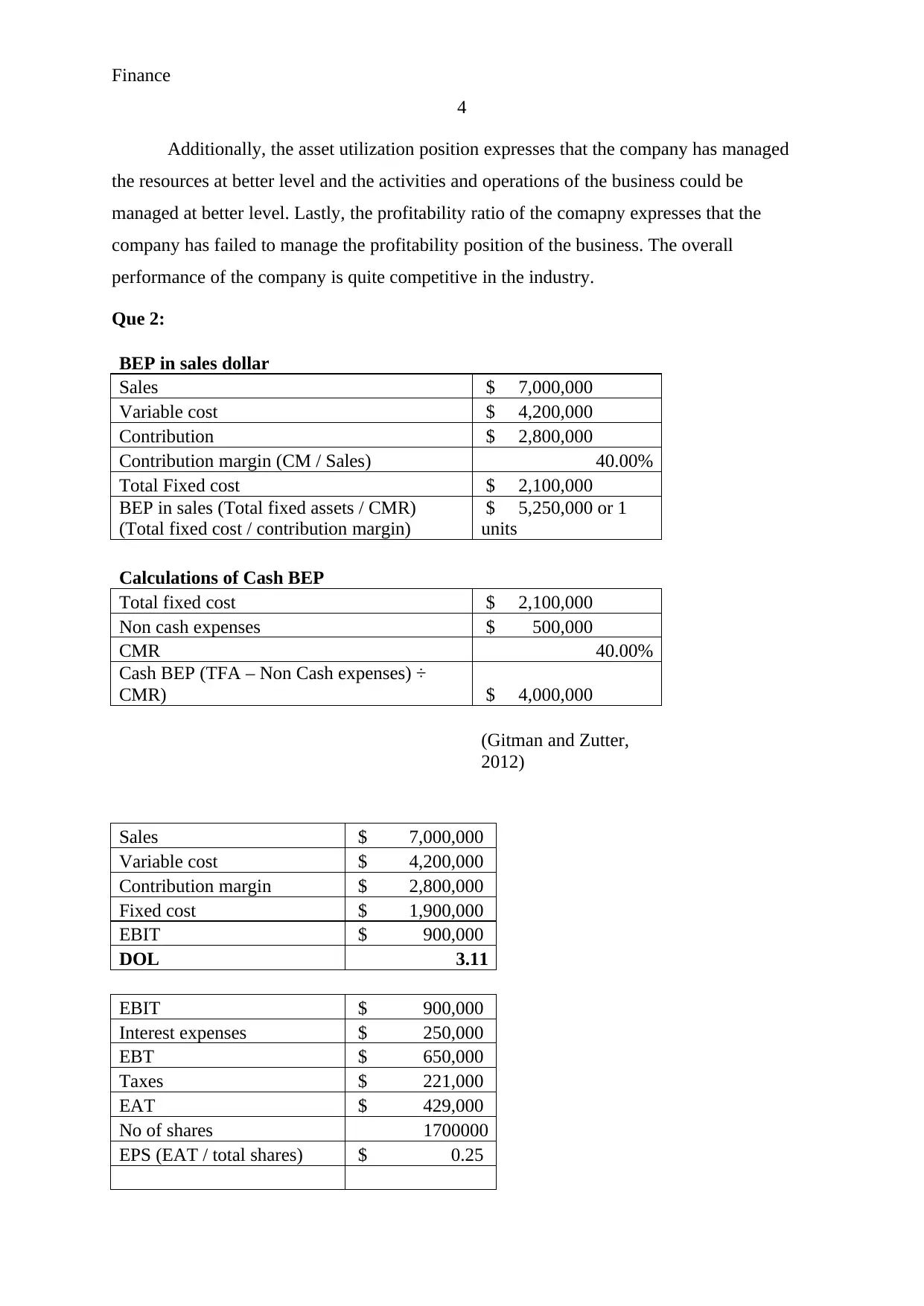
Finance
4
Additionally, the asset utilization position expresses that the company has managed
the resources at better level and the activities and operations of the business could be
managed at better level. Lastly, the profitability ratio of the comapny expresses that the
company has failed to manage the profitability position of the business. The overall
performance of the company is quite competitive in the industry.
Que 2:
BEP in sales dollar
Sales $ 7,000,000
Variable cost $ 4,200,000
Contribution $ 2,800,000
Contribution margin (CM / Sales) 40.00%
Total Fixed cost $ 2,100,000
BEP in sales (Total fixed assets / CMR)
(Total fixed cost / contribution margin)
$ 5,250,000 or 1
units
Calculations of Cash BEP
Total fixed cost $ 2,100,000
Non cash expenses $ 500,000
CMR 40.00%
Cash BEP (TFA – Non Cash expenses) ÷
CMR) $ 4,000,000
(Gitman and Zutter,
2012)
Sales $ 7,000,000
Variable cost $ 4,200,000
Contribution margin $ 2,800,000
Fixed cost $ 1,900,000
EBIT $ 900,000
DOL 3.11
EBIT $ 900,000
Interest expenses $ 250,000
EBT $ 650,000
Taxes $ 221,000
EAT $ 429,000
No of shares 1700000
EPS (EAT / total shares) $ 0.25
4
Additionally, the asset utilization position expresses that the company has managed
the resources at better level and the activities and operations of the business could be
managed at better level. Lastly, the profitability ratio of the comapny expresses that the
company has failed to manage the profitability position of the business. The overall
performance of the company is quite competitive in the industry.
Que 2:
BEP in sales dollar
Sales $ 7,000,000
Variable cost $ 4,200,000
Contribution $ 2,800,000
Contribution margin (CM / Sales) 40.00%
Total Fixed cost $ 2,100,000
BEP in sales (Total fixed assets / CMR)
(Total fixed cost / contribution margin)
$ 5,250,000 or 1
units
Calculations of Cash BEP
Total fixed cost $ 2,100,000
Non cash expenses $ 500,000
CMR 40.00%
Cash BEP (TFA – Non Cash expenses) ÷
CMR) $ 4,000,000
(Gitman and Zutter,
2012)
Sales $ 7,000,000
Variable cost $ 4,200,000
Contribution margin $ 2,800,000
Fixed cost $ 1,900,000
EBIT $ 900,000
DOL 3.11
EBIT $ 900,000
Interest expenses $ 250,000
EBT $ 650,000
Taxes $ 221,000
EAT $ 429,000
No of shares 1700000
EPS (EAT / total shares) $ 0.25
Secure Best Marks with AI Grader
Need help grading? Try our AI Grader for instant feedback on your assignments.
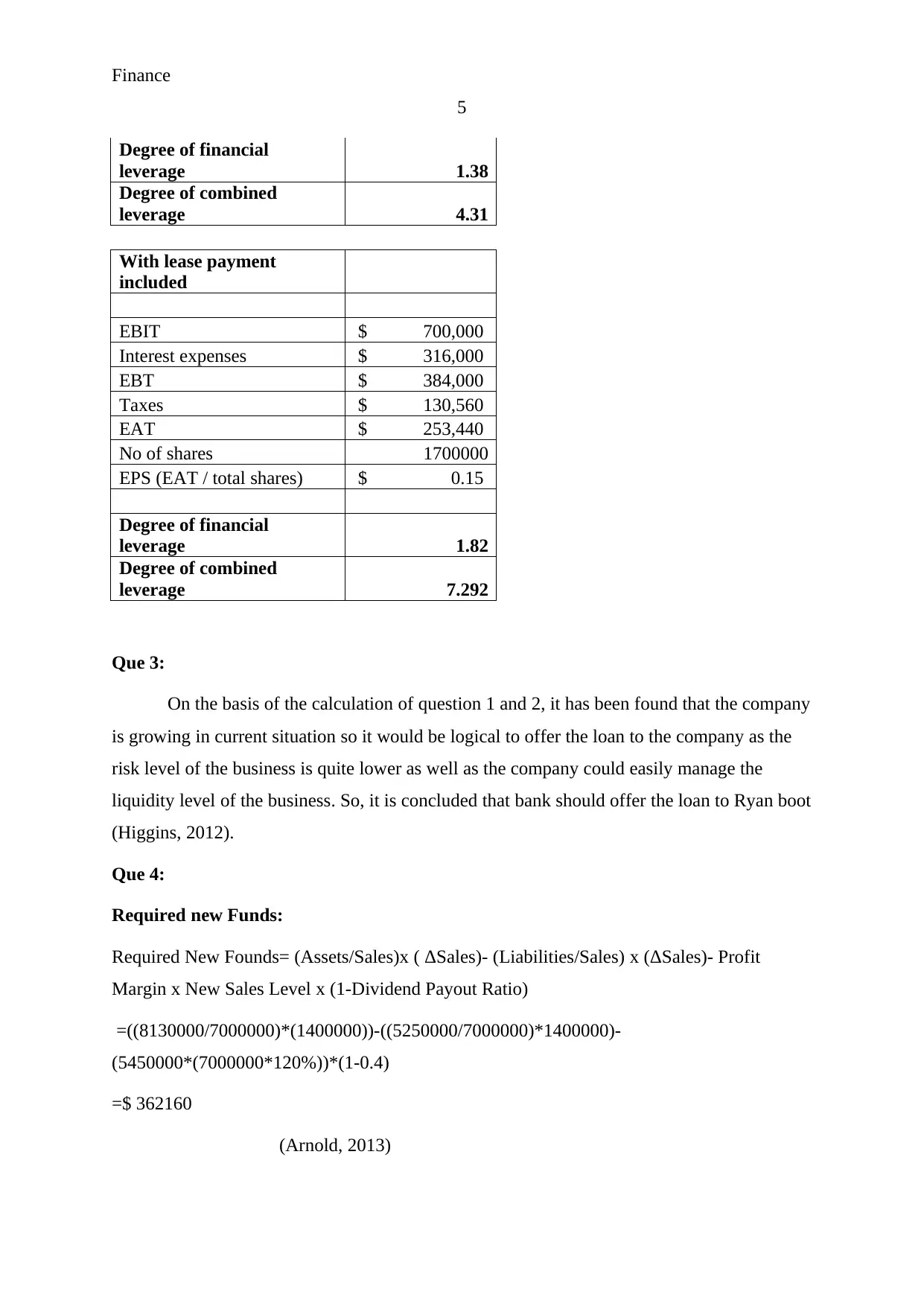
Finance
5
Degree of financial
leverage 1.38
Degree of combined
leverage 4.31
With lease payment
included
EBIT $ 700,000
Interest expenses $ 316,000
EBT $ 384,000
Taxes $ 130,560
EAT $ 253,440
No of shares 1700000
EPS (EAT / total shares) $ 0.15
Degree of financial
leverage 1.82
Degree of combined
leverage 7.292
Que 3:
On the basis of the calculation of question 1 and 2, it has been found that the company
is growing in current situation so it would be logical to offer the loan to the company as the
risk level of the business is quite lower as well as the company could easily manage the
liquidity level of the business. So, it is concluded that bank should offer the loan to Ryan boot
(Higgins, 2012).
Que 4:
Required new Funds:
Required New Founds= (Assets/Sales)x ( ΔSales)- (Liabilities/Sales) x (ΔSales)- Profit
Margin x New Sales Level x (1-Dividend Payout Ratio)
=((8130000/7000000)*(1400000))-((5250000/7000000)*1400000)-
(5450000*(7000000*120%))*(1-0.4)
=$ 362160
(Arnold, 2013)
5
Degree of financial
leverage 1.38
Degree of combined
leverage 4.31
With lease payment
included
EBIT $ 700,000
Interest expenses $ 316,000
EBT $ 384,000
Taxes $ 130,560
EAT $ 253,440
No of shares 1700000
EPS (EAT / total shares) $ 0.15
Degree of financial
leverage 1.82
Degree of combined
leverage 7.292
Que 3:
On the basis of the calculation of question 1 and 2, it has been found that the company
is growing in current situation so it would be logical to offer the loan to the company as the
risk level of the business is quite lower as well as the company could easily manage the
liquidity level of the business. So, it is concluded that bank should offer the loan to Ryan boot
(Higgins, 2012).
Que 4:
Required new Funds:
Required New Founds= (Assets/Sales)x ( ΔSales)- (Liabilities/Sales) x (ΔSales)- Profit
Margin x New Sales Level x (1-Dividend Payout Ratio)
=((8130000/7000000)*(1400000))-((5250000/7000000)*1400000)-
(5450000*(7000000*120%))*(1-0.4)
=$ 362160
(Arnold, 2013)
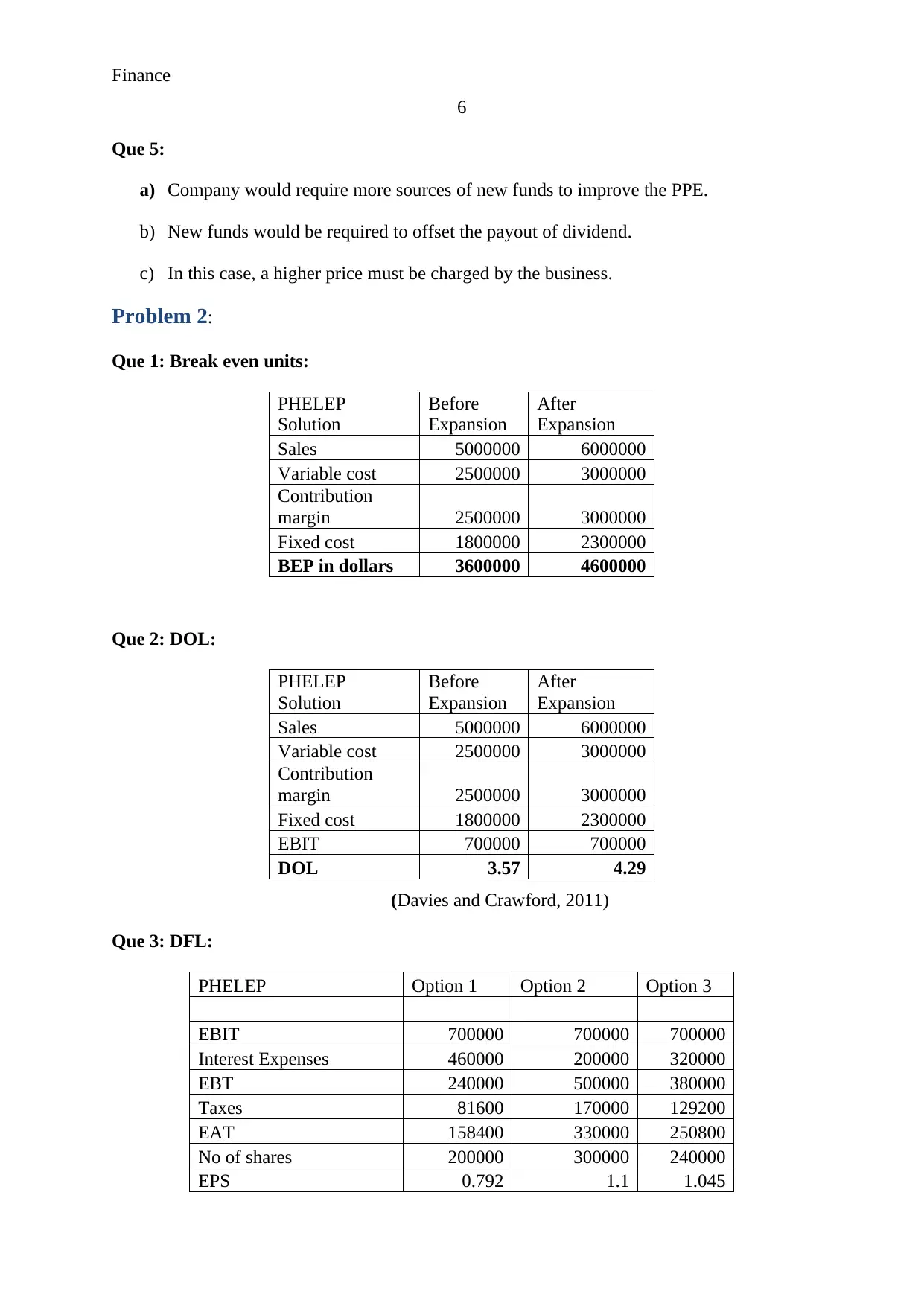
Finance
6
Que 5:
a) Company would require more sources of new funds to improve the PPE.
b) New funds would be required to offset the payout of dividend.
c) In this case, a higher price must be charged by the business.
Problem 2:
Que 1: Break even units:
PHELEP
Solution
Before
Expansion
After
Expansion
Sales 5000000 6000000
Variable cost 2500000 3000000
Contribution
margin 2500000 3000000
Fixed cost 1800000 2300000
BEP in dollars 3600000 4600000
Que 2: DOL:
PHELEP
Solution
Before
Expansion
After
Expansion
Sales 5000000 6000000
Variable cost 2500000 3000000
Contribution
margin 2500000 3000000
Fixed cost 1800000 2300000
EBIT 700000 700000
DOL 3.57 4.29
(Davies and Crawford, 2011)
Que 3: DFL:
PHELEP Option 1 Option 2 Option 3
EBIT 700000 700000 700000
Interest Expenses 460000 200000 320000
EBT 240000 500000 380000
Taxes 81600 170000 129200
EAT 158400 330000 250800
No of shares 200000 300000 240000
EPS 0.792 1.1 1.045
6
Que 5:
a) Company would require more sources of new funds to improve the PPE.
b) New funds would be required to offset the payout of dividend.
c) In this case, a higher price must be charged by the business.
Problem 2:
Que 1: Break even units:
PHELEP
Solution
Before
Expansion
After
Expansion
Sales 5000000 6000000
Variable cost 2500000 3000000
Contribution
margin 2500000 3000000
Fixed cost 1800000 2300000
BEP in dollars 3600000 4600000
Que 2: DOL:
PHELEP
Solution
Before
Expansion
After
Expansion
Sales 5000000 6000000
Variable cost 2500000 3000000
Contribution
margin 2500000 3000000
Fixed cost 1800000 2300000
EBIT 700000 700000
DOL 3.57 4.29
(Davies and Crawford, 2011)
Que 3: DFL:
PHELEP Option 1 Option 2 Option 3
EBIT 700000 700000 700000
Interest Expenses 460000 200000 320000
EBT 240000 500000 380000
Taxes 81600 170000 129200
EAT 158400 330000 250800
No of shares 200000 300000 240000
EPS 0.792 1.1 1.045
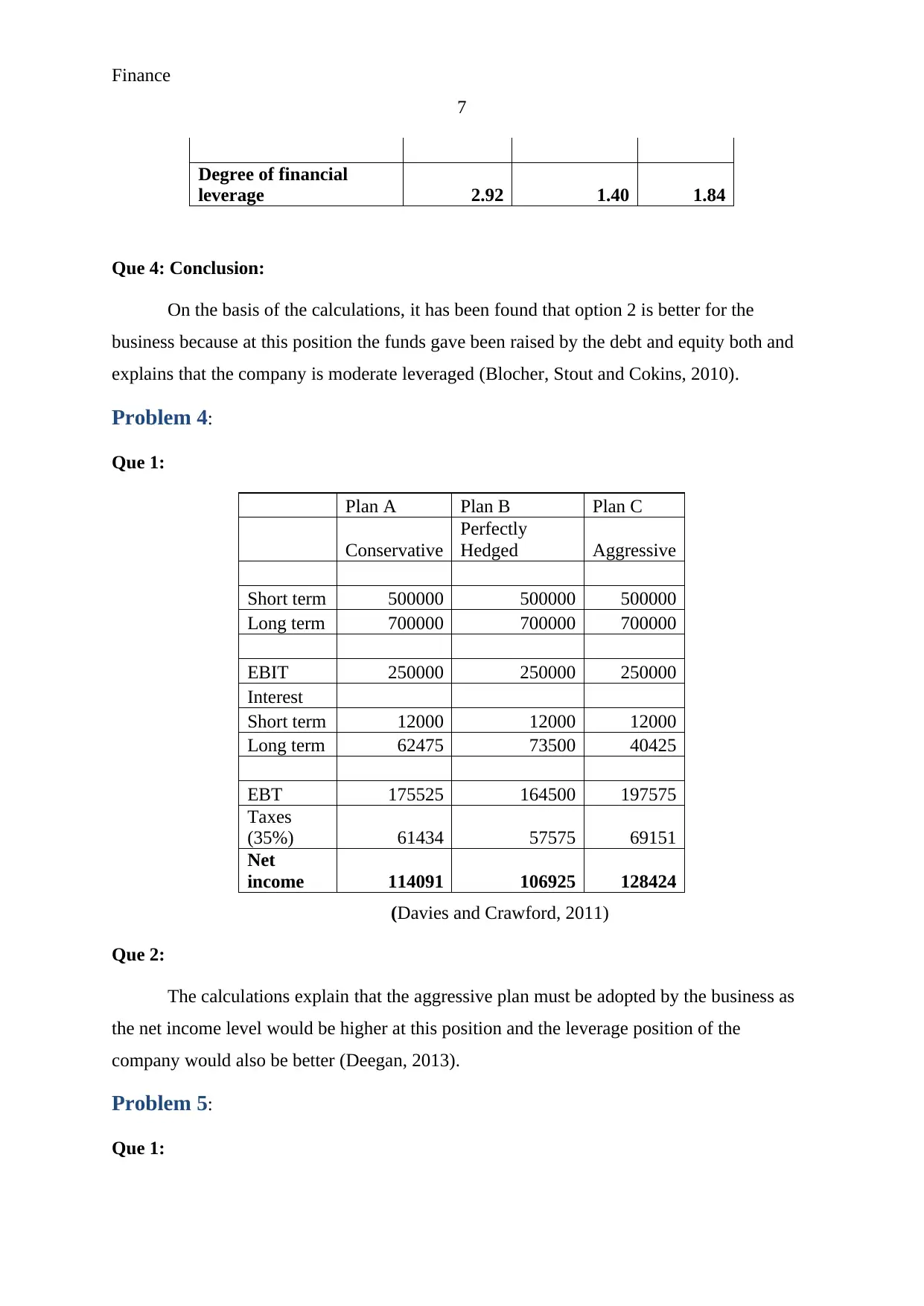
Finance
7
Degree of financial
leverage 2.92 1.40 1.84
Que 4: Conclusion:
On the basis of the calculations, it has been found that option 2 is better for the
business because at this position the funds gave been raised by the debt and equity both and
explains that the company is moderate leveraged (Blocher, Stout and Cokins, 2010).
Problem 4:
Que 1:
Plan A Plan B Plan C
Conservative
Perfectly
Hedged Aggressive
Short term 500000 500000 500000
Long term 700000 700000 700000
EBIT 250000 250000 250000
Interest
Short term 12000 12000 12000
Long term 62475 73500 40425
EBT 175525 164500 197575
Taxes
(35%) 61434 57575 69151
Net
income 114091 106925 128424
(Davies and Crawford, 2011)
Que 2:
The calculations explain that the aggressive plan must be adopted by the business as
the net income level would be higher at this position and the leverage position of the
company would also be better (Deegan, 2013).
Problem 5:
Que 1:
7
Degree of financial
leverage 2.92 1.40 1.84
Que 4: Conclusion:
On the basis of the calculations, it has been found that option 2 is better for the
business because at this position the funds gave been raised by the debt and equity both and
explains that the company is moderate leveraged (Blocher, Stout and Cokins, 2010).
Problem 4:
Que 1:
Plan A Plan B Plan C
Conservative
Perfectly
Hedged Aggressive
Short term 500000 500000 500000
Long term 700000 700000 700000
EBIT 250000 250000 250000
Interest
Short term 12000 12000 12000
Long term 62475 73500 40425
EBT 175525 164500 197575
Taxes
(35%) 61434 57575 69151
Net
income 114091 106925 128424
(Davies and Crawford, 2011)
Que 2:
The calculations explain that the aggressive plan must be adopted by the business as
the net income level would be higher at this position and the leverage position of the
company would also be better (Deegan, 2013).
Problem 5:
Que 1:
Paraphrase This Document
Need a fresh take? Get an instant paraphrase of this document with our AI Paraphraser
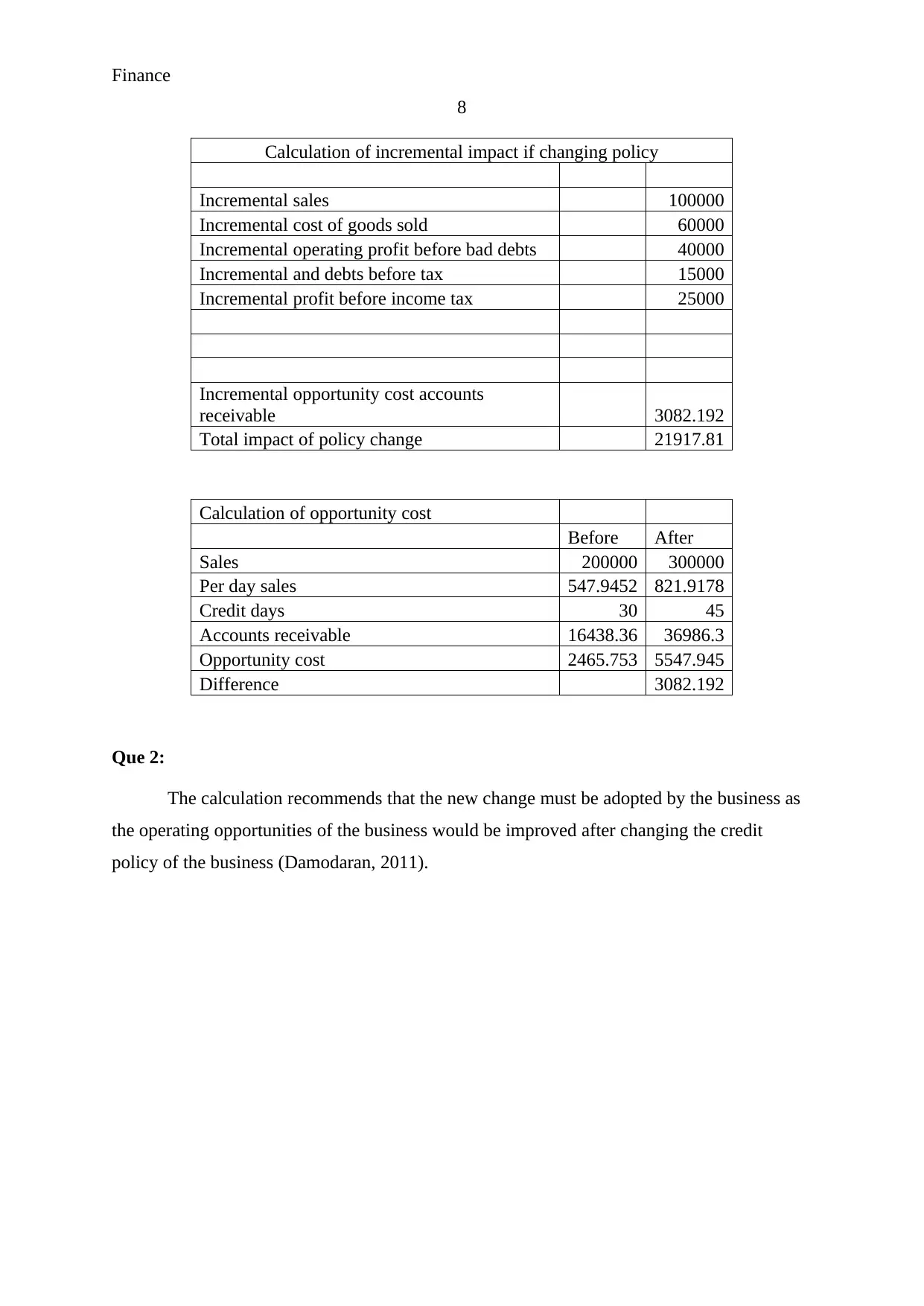
Finance
8
Calculation of incremental impact if changing policy
Incremental sales 100000
Incremental cost of goods sold 60000
Incremental operating profit before bad debts 40000
Incremental and debts before tax 15000
Incremental profit before income tax 25000
Incremental opportunity cost accounts
receivable 3082.192
Total impact of policy change 21917.81
Calculation of opportunity cost
Before After
Sales 200000 300000
Per day sales 547.9452 821.9178
Credit days 30 45
Accounts receivable 16438.36 36986.3
Opportunity cost 2465.753 5547.945
Difference 3082.192
Que 2:
The calculation recommends that the new change must be adopted by the business as
the operating opportunities of the business would be improved after changing the credit
policy of the business (Damodaran, 2011).
8
Calculation of incremental impact if changing policy
Incremental sales 100000
Incremental cost of goods sold 60000
Incremental operating profit before bad debts 40000
Incremental and debts before tax 15000
Incremental profit before income tax 25000
Incremental opportunity cost accounts
receivable 3082.192
Total impact of policy change 21917.81
Calculation of opportunity cost
Before After
Sales 200000 300000
Per day sales 547.9452 821.9178
Credit days 30 45
Accounts receivable 16438.36 36986.3
Opportunity cost 2465.753 5547.945
Difference 3082.192
Que 2:
The calculation recommends that the new change must be adopted by the business as
the operating opportunities of the business would be improved after changing the credit
policy of the business (Damodaran, 2011).
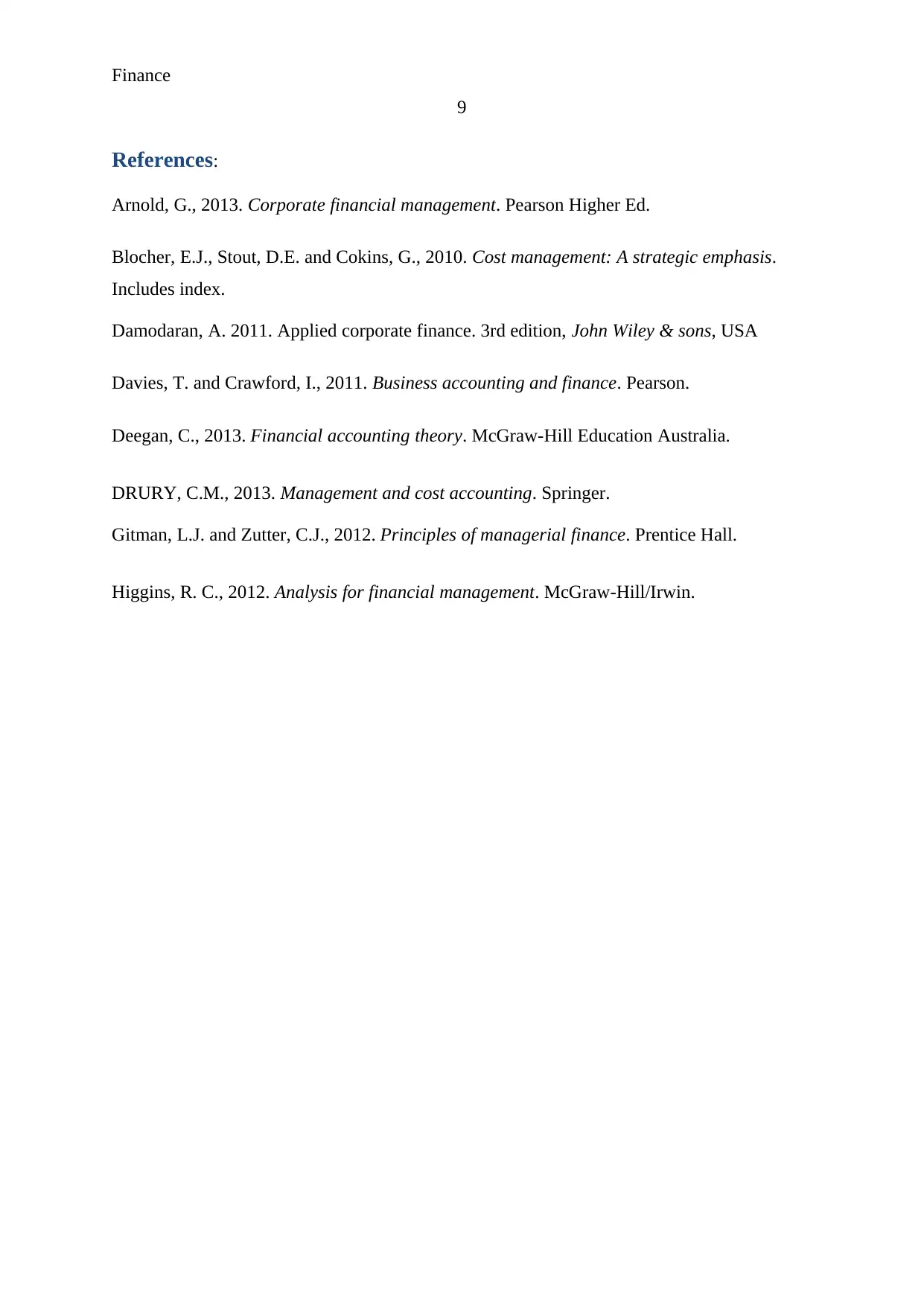
Finance
9
References:
Arnold, G., 2013. Corporate financial management. Pearson Higher Ed.
Blocher, E.J., Stout, D.E. and Cokins, G., 2010. Cost management: A strategic emphasis.
Includes index.
Damodaran, A. 2011. Applied corporate finance. 3rd edition, John Wiley & sons, USA
Davies, T. and Crawford, I., 2011. Business accounting and finance. Pearson.
Deegan, C., 2013. Financial accounting theory. McGraw-Hill Education Australia.
DRURY, C.M., 2013. Management and cost accounting. Springer.
Gitman, L.J. and Zutter, C.J., 2012. Principles of managerial finance. Prentice Hall.
Higgins, R. C., 2012. Analysis for financial management. McGraw-Hill/Irwin.
9
References:
Arnold, G., 2013. Corporate financial management. Pearson Higher Ed.
Blocher, E.J., Stout, D.E. and Cokins, G., 2010. Cost management: A strategic emphasis.
Includes index.
Damodaran, A. 2011. Applied corporate finance. 3rd edition, John Wiley & sons, USA
Davies, T. and Crawford, I., 2011. Business accounting and finance. Pearson.
Deegan, C., 2013. Financial accounting theory. McGraw-Hill Education Australia.
DRURY, C.M., 2013. Management and cost accounting. Springer.
Gitman, L.J. and Zutter, C.J., 2012. Principles of managerial finance. Prentice Hall.
Higgins, R. C., 2012. Analysis for financial management. McGraw-Hill/Irwin.
1 out of 9
Related Documents
Your All-in-One AI-Powered Toolkit for Academic Success.
+13062052269
info@desklib.com
Available 24*7 on WhatsApp / Email
![[object Object]](/_next/static/media/star-bottom.7253800d.svg)
Unlock your academic potential
© 2024 | Zucol Services PVT LTD | All rights reserved.
